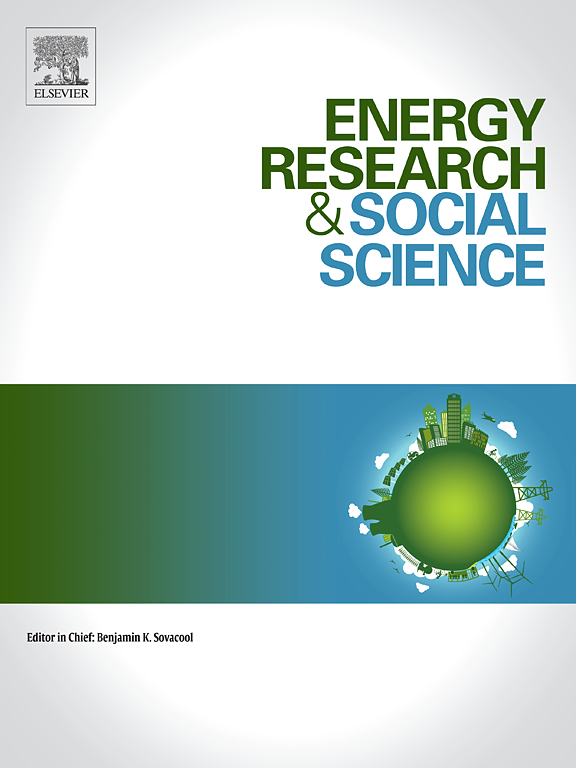Quantifying minimum mobility and transport needs: The who, the where and the why
IF 7.4
2区 经济学
Q1 ENVIRONMENTAL STUDIES
引用次数: 0
Abstract
The concept of “sustainable consumption corridors” bridges two topics critical to assessing energy and transport systems: human wellbeing and planetary boundaries. However, large disagreements remain regarding how to define minimum, essential and decent levels of demand, which form the floor of such corridors. Aggregate approaches based upon distance travelled (e.g. passenger-kilometres) are insufficient, as they omit why people move. To address this gap, we build upon established theories of fundamental human needs and needs-oriented mobility research to define “decent mobility” as the condition when an individual can enact a set of trips that allow satisfaction of their needs, within their resources and capabilities. We explain how this definition unifies (i) individual capabilities and resources (time, money), (ii) available physical infrastructure and services, and (iii) socio-political contexts that shape personal freedom. We then operationalise and quantify decent mobility with a “persona” approach. We model two case studies with very distinct mobility systems – Switzerland and Mauritius – to illustrate the flexibility of the framework. They show which methods and data sources are required to consistently assess decent mobility of individuals, as well as travel time, distance, energy use, and emissions. Overall, the framework offers a method for evaluating present and future transport systems by putting human needs and their heterogeneity at the centre.

量化最低流动性和运输需求:谁,在哪里和为什么
“可持续消费走廊”的概念连接了对评估能源和运输系统至关重要的两个主题:人类福祉和地球边界。然而,在如何界定构成这些走廊底层的最低、基本和体面需求水平方面,仍存在巨大分歧。基于旅行距离(如乘客公里)的综合方法是不够的,因为它们忽略了人们移动的原因。为了解决这一差距,我们建立在人类基本需求和需求导向流动性研究的既定理论基础上,将“体面的流动性”定义为个人能够在其资源和能力范围内制定一系列满足其需求的旅行的条件。我们解释了这个定义如何统一(i)个人能力和资源(时间、金钱),(ii)可用的物理基础设施和服务,以及(iii)塑造个人自由的社会政治背景。然后,我们用“角色”方法对体面的流动性进行操作和量化。我们对瑞士和毛里求斯两个非常不同的交通系统的案例研究进行了建模,以说明该框架的灵活性。它们显示了需要哪些方法和数据来源来持续评估个人的体面流动性,以及旅行时间、距离、能源使用和排放。总体而言,该框架通过将人类需求及其异质性置于中心位置,为评估当前和未来的运输系统提供了一种方法。
本文章由计算机程序翻译,如有差异,请以英文原文为准。
求助全文
约1分钟内获得全文
求助全文
来源期刊

Energy Research & Social Science
ENVIRONMENTAL STUDIES-
CiteScore
14.00
自引率
16.40%
发文量
441
审稿时长
55 days
期刊介绍:
Energy Research & Social Science (ERSS) is a peer-reviewed international journal that publishes original research and review articles examining the relationship between energy systems and society. ERSS covers a range of topics revolving around the intersection of energy technologies, fuels, and resources on one side and social processes and influences - including communities of energy users, people affected by energy production, social institutions, customs, traditions, behaviors, and policies - on the other. Put another way, ERSS investigates the social system surrounding energy technology and hardware. ERSS is relevant for energy practitioners, researchers interested in the social aspects of energy production or use, and policymakers.
Energy Research & Social Science (ERSS) provides an interdisciplinary forum to discuss how social and technical issues related to energy production and consumption interact. Energy production, distribution, and consumption all have both technical and human components, and the latter involves the human causes and consequences of energy-related activities and processes as well as social structures that shape how people interact with energy systems. Energy analysis, therefore, needs to look beyond the dimensions of technology and economics to include these social and human elements.
 求助内容:
求助内容: 应助结果提醒方式:
应助结果提醒方式:


